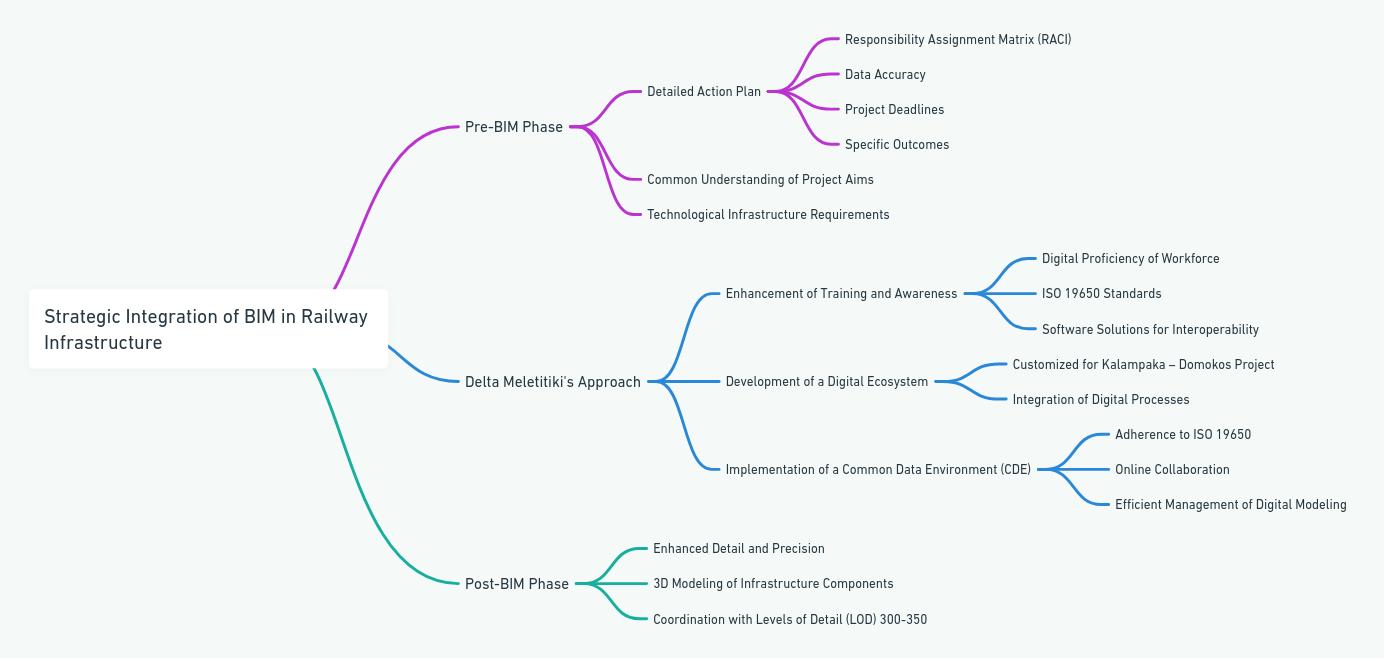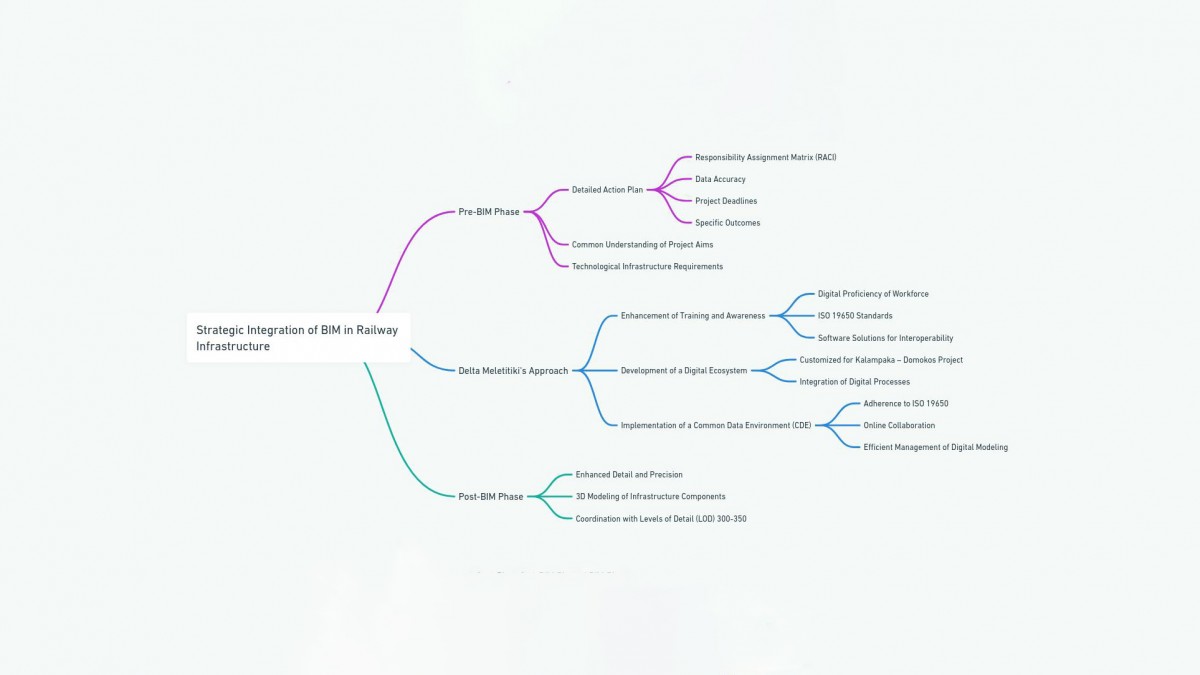Pre-BIM as a Foundational Phase for Project Delivery: In project delivery to clients, the pre-BIM phase stands as a crucial foundation.
It necessitates the formulation of a detailed and comprehensive action plan, incorporating a Responsibility Assignment Matrix (RACI) to delineate the duties related to data accuracy, project deadlines, and specific outcomes. This initial phase is particularly vital in scenarios where BIM is being introduced for the first time, ensuring all stakeholders share a common understanding of the project's aims and the technological infrastructure required for its realization. Such thorough preparation is instrumental in averting discrepancies between the actual project execution and the client's expectations, a scenario frequently encountered in areas where BIM technology is still in its introductory stages. This becomes even more significant in the context of railway infrastructure projects, which are relatively rare on a global scale.
Delta Meletitiki's Innovative BIM Strategies in Infrastructure: Delta Meletitiki, renowned for its leadership in railway infrastructure and digital transformation, showcases strategic excellence in embedding BIM into pioneering projects across Europe and worldwide. The company's approach to the Kalampaka – Domokos rail project, conducted for AVAX and ERGOSE, exemplifies its forward-thinking in overcoming BIM-centric challenges. The project, with a budget of €52.2 million and a 36-month timeline aimed at inaugurating the electrified railway by the end of 2025, benefits from EU co-funding under the NSRF 2014-2020 program. In particular, Delta Meletitiki's methodical approach was:
- Enhancement of Training and Awareness: Acknowledging the pivotal role of expertise for BIM success, Delta Meletitiki initiated a comprehensive training scheme to bolster the digital proficiency of its workforce, from the executive level to field operations. This initiative was designed to augment their comprehension of digitalization within infrastructure and leverage the advantages of ISO 19650 standards. It also involved equipping the team with software solutions that enable interoperability of digital files, thus facilitating data integration and the enhancement of digital railway infrastructure models.
- Development of a Digital Ecosystem: Prior to contract finalization, Delta Meletitiki engineered a custom digital ecosystem tailored for the Kalampaka – Domokos project. This preemptive strategy was aimed at ensuring the project's readiness, accommodating its distinct requirements through the integration of digital processes from the onset.
- Implementation of a Common Data Environment (CDE): In adherence to ISO 19650 guidelines, Delta Meletitiki adopted a CDE to optimize digital modeling and collaborative efforts. This facilitated seamless online collaboration and efficient management of digital modeling tasks across various project elements, like track lines and electrification systems. Within this framework, Delta Meletitiki, AVAX, and Ergose gained direct access to the modeling workflow and files, substantially improving the management of the digital information modeling process and aiming to minimize potential project risks.
The digital railway project's work breakdown structure and modeling tasks are meticulously outlined during the Pre-BIM phase, including 3D modeling of infrastructure components and coordination, with Levels of Detail (LOD) ranging between 300 and 350. The Post-BIM phase is committed to achieving enhanced detail and precision.

Here is a mind map illustrating the strategic integration of BIM in railway infrastructure, focusing on Delta Meletitiki's approach. In particular, The diagram visually represents the strategic integration of Building Information Modeling (BIM) in railway infrastructure, focusing on the approach taken by Delta Meletitiki. It is structured into three main phases: Pre-BIM, Delta Meletitiki's Approach, and Post-BIM, each containing key components and strategies employed throughout the project lifecycle. Here's a breakdown of the diagram:
Pre-BIM Phase
- ⦁ Detailed Action Plan: This includes the creation of a Responsibility Assignment Matrix (RACI) to clarify roles concerning data accuracy, project deadlines, and specific outcomes.
- ⦁ Common Understanding of Project Aims: Ensuring all stakeholders have a shared vision of the project goals. ⦁ Technological Infrastructure Requirements: Identifying the technological needs for the project's successful execution.
Delta Meletitiki's Approach
- ⦁ Enhancement of Training and Awareness:
- Digital Proficiency of Workforce: Implementing comprehensive training to improve the team's understanding of digitalization in infrastructure.
- ISO 19650 Standards: Educating the team on these standards to enhance project execution.
- Software Solutions for Interoperability: Equipping the team with tools that facilitate the integration of digital files.
- Implementation of a Common Data Environment (CDE):
- Adherence to ISO 19650: Following these guidelines to optimize digital modeling and collaboration.
- Online Collaboration: Enabling seamless collaboration across the project team.
- Efficient Management of Digital Modeling: Streamlining the management of digital modeling tasks.
- Development of a Digital Ecosystem: Customized for Kalampaka – Domokos Project:
- Tailoring a digital ecosystem to meet the specific needs of the project.
- Integration of Digital Processes: Incorporating digital processes from the start to ensure project readiness.
Post-BIM Phase
- Enhanced Detail and Precision: Focusing on achieving higher levels of detail and accuracy in the project's later stages.
- 3D Modeling of Infrastructure Components: Creating detailed 3D models of the infrastructure components.
- Coordination with Levels of Detail (LOD) 300-350: Ensuring that the models meet specific levels of detail for accurate representation and analysis.
Through addressing these challenges head-on, Delta Meletitiki not only guarantees the successful realization of intricate projects but also sets a benchmark for the integration of BIM and digital methodologies in railway infrastructure endeavors. Their strategy highlights the importance of in-depth preparation, the establishment of a digital ecosystem, and continuous education in managing the distinct challenges posed by BIM implementation in expansive projects.
